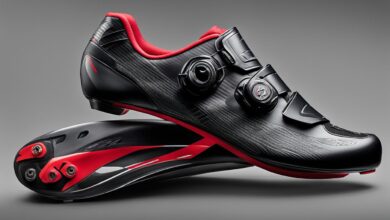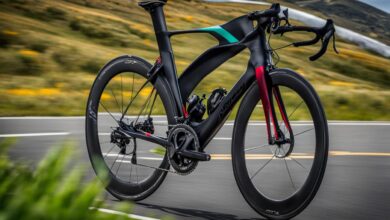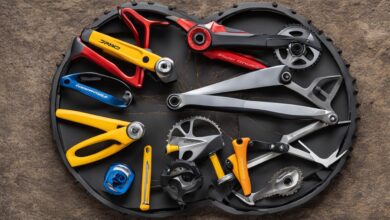Clipless Pedal Systems: Enhancing Your Ride
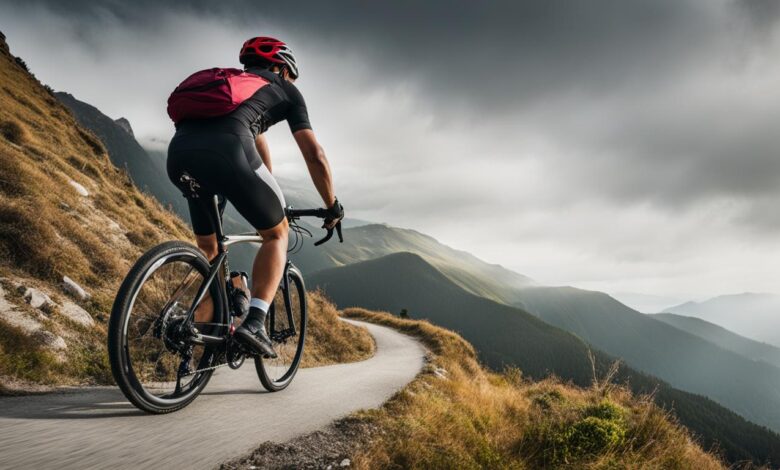
If you’re a cycling enthusiast, you know that having the right gear can make all the difference in your performance. One of the most important components of your cycling setup is the bike pedals. They are crucial in transferring your power to the bike and determining your riding efficiency. That’s why many cyclists have switched to using clipless pedal systems.
Clipless pedal systems are a revolutionary advancement in cycling equipment. Unlike traditional platform pedals, they offer a more secure and efficient connection between your feet and the pedals, resulting in a more comfortable and productive ride.
Key Takeaways
- Clipless pedal systems provide a more secure and efficient connection between your feet and the pedals.
- They can enhance your cycling experience by improving pedal efficiency, enhancing control, and providing a more stable ride.
- Bicycle cleats securely attach to the clipless pedals, allowing for easy engagement and disengagement.
- Choosing the right clipless pedal system is essential for optimal cycling performance.
- Mastering clipless pedal engagement and disengagement takes practice but can greatly enhance your ride.
The Benefits of Clipless Pedal Systems
Clipless pedal systems offer a range of benefits to cyclists looking to upgrade their pedal experience. The integration of cycling pedal systems with pedal retention systems provides a more stable and efficient connection between your feet and the pedals, which can help improve your cycling performance and comfort.
Let’s dive into the benefits of clipless pedal systems:
1. Pedal Efficiency
Clipless pedal systems improve pedal efficiency by allowing you to generate power on both the upstroke and downstroke of your pedal stroke. With traditional flat pedals, you only generate power while pushing down; with clipless pedals, your feet are connected to the pedals, enabling you to pull up on the pedals as well. This means that you can generate more power with each pedal stroke, leading to a faster and more efficient ride.
2. Control
Clipless pedals and pedal retention systems enhance control by providing a secure connection between your feet and the pedals. This connection ensures that your feet do not slip off the pedals, even when riding rough terrain or during rapid acceleration. The ability to maintain constant contact with the pedals allows you to maintain better balance and control on your bike, leading to a more confident ride.
3. Safer and More Secure Ride
Clipless pedal systems offer a more secure ride by keeping your feet firmly attached to the pedals, reducing the risk of slipping off and falling off your bike. The retention systems in clipless pedals lock your shoes in place, providing a stable platform for pedaling and reducing the chance of accidents. Additionally, the design of clipless pedals ensures that your foot can only be released from the pedal when you intentionally twist your ankle. This makes clipless pedals a safer alternative to traditional pedals, especially during high-intensity or technical rides.
How Clipless Pedal Systems Work
Clipless pedal systems consist of two main components – the pedal and the cleat. The cleat attaches to the bottom of the cycling shoe and clips into the pedal, creating a secure connection between the foot and the pedal. This system allows for efficient power transfer and greater control over the bike.
The technology behind clipless pedal systems involves a spring-loaded mechanism within the pedal that engages with the cleat. The engagement is typically achieved by pushing the cleat down onto the pedal, and the release is achieved by twisting the heel outward.
The cleat mechanism is designed to allow for a small amount of rotational movement of the foot, known as float. This allows for more natural movement of the knee and reduces the risk of injury. Some clipless pedal systems allow for adjustable float to cater to individual preferences.
Choosing the Right Clipless Pedal System
Investing in the right clipless pedal system can significantly enhance your cycling experience. However, with so many options available, it can be challenging to make the right choice. Here, we will guide you through the process of selecting a clipless pedal system that meets your specific needs.
Factors to Consider
Before making a purchase, consider the following factors:
- Pedal Type: Choose a pedal system that is appropriate for your cycling discipline and personal preferences.
- Float: Float refers to the degree of rotation that the foot can move while connected to the pedal. Consider your riding style and comfort level when choosing the right float for you.
- Compatibility with Cycling Shoes: Ensure that the clips on the pedal system are compatible with your cycling shoes.
Popular Clipless Pedal Systems
There are several clipless pedal systems available in the market, each with its unique features and benefits. Some of the most popular options include:
| Pedal System | Key Features | Price Range |
|---|---|---|
| Shimano SPD-SL | Large platform, wide cleat for stability, low stack height, adjustable tension | $100-$200 |
| Look Keo | Wide range of float, lightweight, aerodynamic design | $100-$300 |
| Time Xpresso | Easy engagement and release, adjustable Q-factor, multiple float options | $100-$250 |
Ultimately, the right clipless pedal system for you will depend on your specific needs and preferences. By considering the factors discussed above and exploring various options, you can make an informed decision that enhances your cycling experience.
Installing and Adjusting Clipless Pedals and Cleats
Installing and adjusting clipless pedals and cleats is an easy process that can be done at home with just a few simple steps. Proper positioning, alignment, and tension adjustment are crucial to ensure a comfortable and efficient ride.
Step-by-Step Guide
- Begin by installing the pedals onto your bike. Use a wrench to tighten the pedals securely in place.
- Select the appropriate cleats for your cycling shoes. Make sure the cleats are compatible with your clipless pedal systems.
- Attach the cleats to the bottom of your cycling shoes using screws and a screwdriver. Make sure the cleats are centered under the ball of your foot for optimal positioning.
- Align the cleats with the clipless pedals, ensuring the front of the cleats is parallel with the front of the pedals.
- Adjust the tension on the clipless pedals using the tension adjustment screw. Start with a lower tension and gradually increase it until you find the desired level of resistance.
It’s important to note that different clipless pedal systems may have their own unique installation and adjustment processes, so be sure to consult the manufacturer’s instructions for specific details.
Pro Tip: For beginners, practicing clipping in and out of your pedals on a stationary bike before hitting the road or trail will help you master the technique and build confidence.
By following these simple steps, you can install and adjust your clipless pedals and cleats with ease, ensuring a comfortable and efficient ride. Make sure to periodically check and adjust the alignment and tension of your clipless pedals for optimal performance.
Mastering Clipless Pedal Engagement and Disengagement
Clipless pedal systems can take some time to get used to, but with practice, you can become confident and proficient in using them. Proper engagement and disengagement techniques are critical in getting the most out of your clipless pedals. Here are some tips to help you master clipless pedal engagement and disengagement.
Foot Placement
Start by practicing proper foot placement. Your foot should be positioned directly above the pedal, with your heel slightly raised. As you engage the pedal, push your heel down to make a secure connection. Similarly, disengaging the pedal should begin by lifting your heel and rotating your foot away from the pedal. With practice, this motion will become second nature.
Timing is Everything
The timing of your engage and disengage movements is crucial to a smooth and safe ride. As you approach a stop, disengage your pedals in advance so that you are not caught off guard and risk falling over. Similarly, when starting from a stop, engage one pedal and then the other to ensure a stable and efficient start.
| Engagement and Disengagement Techniques | Description |
|---|---|
| Twist Release | This technique is used to unclip your shoe from the pedal. Simply twist your heel outward to disengage from the pedal. Practice this technique until it becomes second nature. |
| Heel Flick | As the name suggests, this technique involves flicking your heel outward to disengage from the pedal. This technique is particularly useful when you need to unclip quickly, such as in an emergency. |
| Forceful Release | If all else fails, a forceful release can be used to unclip your shoe. Simply pull upward and away from the pedal to release the cleat. Note that this can damage your pedal system, so it should only be used as a last resort. |
Practice Drills
To get comfortable with your clipless pedal system, practice engaging and disengaging your pedals while stationary. Start with one foot clipped in and the other foot on the ground. Engage and disengage your pedal several times, then switch to the other foot. Once you are comfortable with this, try the same drill while rolling slowly.
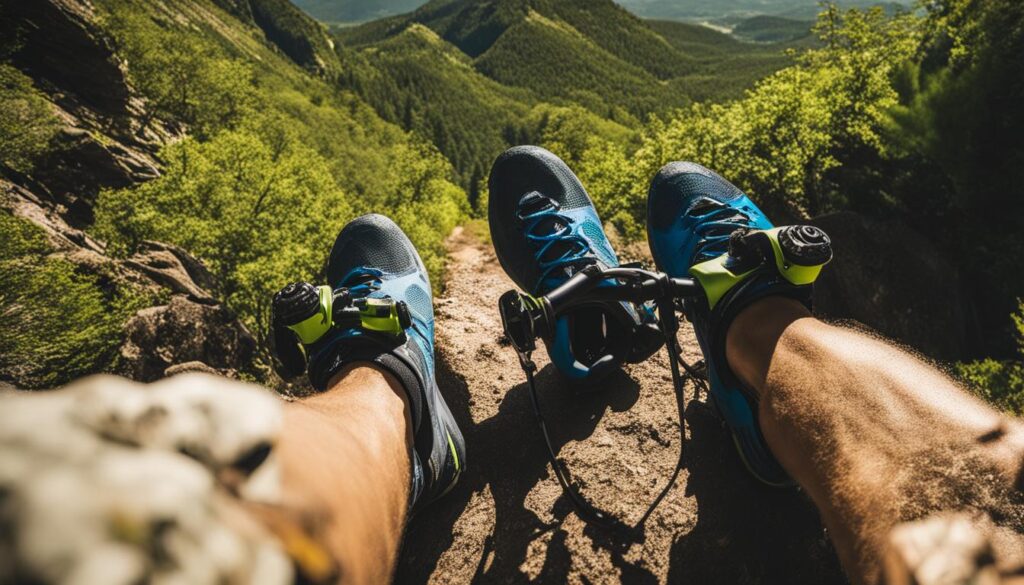
Clipless pedal systems can provide significant benefits for your cycling performance and overall riding experience. By mastering clipless pedal engagement and disengagement, you can take full advantage of the benefits they offer. Keep in mind that it takes practice to master these techniques, so don’t get discouraged if it doesn’t come easily at first. With patience and perseverance, you will soon be riding like a pro!
Clipless Pedal Systems for Different Cycling Disciplines
Clipless pedal systems are versatile and can cater to different cycling disciplines. This section will explore clipless pedal systems that are suitable for road cycling, mountain biking, and other specialized disciplines.
Road Cycling
For road cycling, look for clipless pedal systems that offer a lightweight design, efficient power transfer, and a large pedaling surface area for added stability. Road cycling clipless pedal systems typically have a three-bolt cleat mounting system and allow for a range of float adjustment. Choose systems that offer durable materials such as carbon fiber or titanium.
Mountain Biking
When it comes to mountain biking, opt for clipless pedal systems that offer a more secure connection, even in rough terrain. Consider using double-sided pedals that allow for easy engagement and disengagement. Mountain biking clipless pedal systems usually have a two-bolt cleat mounting system and offer a range of release tension adjustment options for added safety. Look for systems that are lightweight but also durable enough to withstand harsh trail conditions.
Other Specialized Disciplines
Clipless pedal systems can also cater to other specialized cycling disciplines such as cyclocross, triathlon, and touring. For cyclocross, consider pedal systems that offer mud-shedding properties and a secure connection in muddy conditions. Triathletes may prefer clipless pedal systems that allow for fast transition times and efficient pedaling. Touring cyclists may opt for pedal systems that offer adjustable float and a comfortable platform for long-distance rides.
When choosing clipless pedal systems, it is vital to consider the specific demands of your chosen cycling discipline. Selecting the right system will enhance your riding experience and improve your performance on the bike
Troubleshooting Common Clipless Pedal Issues
Clipless pedal systems are a great addition to any bike, but like any equipment, they can sometimes cause problems. Here are some common issues that riders may encounter when using clipless pedal systems, along with some troubleshooting solutions:
1. Pedal Squeaking
If your clipless pedals make a squeaking noise when you pedal, it may be due to loose pedals or cleats. Try tightening the pedals and cleats or adding some lubricant to the pedal mechanism. If the squeaking continues, it may be time for new pedals or cleats.
2. Cleat Slipping
If your cleats are slipping out of the pedal, it may be due to worn or damaged cleats. Check the cleats if they are worn out and replace them. You might also consider adjusting the tension on your pedals or tightening the cleat screws.
3. Difficulty Engaging or Disengaging
If you’re having trouble engaging or disengaging your clipless pedals, it could be due to incorrect cleat placement or tension. Make sure your cleats are positioned correctly on your shoes, and try adjusting the tension to find the right balance between easy engagement and secure connection.
4. Maintenance Tips
To keep your clipless pedal system in optimal condition, regularly clean the pedals, cleats, and shoe soles to prevent dirt buildup. Check the cleat screws frequently to ensure they are tight, and replace the cleats if they show signs of wear and tear. Proper maintenance will help your clipless pedals function smoothly and last longer.
Investing in quality clipless pedals and bike accessories can significantly improve your riding experience. However, it is essential to know the common issues that can arise with clipless pedal systems and how to troubleshoot them. Take care of your equipment, and it will take care of you.
Clipless Pedals vs. Platform Pedals: Pros and Cons
Choosing the right pedal system is critical to achieving your desired cycling performance. Clipless pedal systems and platform pedals are two of the most common options available in the market. Each system has its own advantages and disadvantages, and the choice ultimately depends on your cycling style and preferences.
Clipless Pedals
Clipless pedals require cycling shoes that have specialized cleats attached to the soles. The cleats securely clip into the pedal, providing a connection between your feet and the bike. The primary benefits of clipless pedals are improved efficiency and bike control. By keeping your feet in the optimal position throughout the pedal stroke, you can apply power more consistently, resulting in a smoother and more efficient ride. Additionally, clipless pedals allow for a stable connection between your feet and the pedals, providing better control and balance, particularly in challenging terrains and situations. On the downside, clipless pedals require a learning curve and may take some time to become accustomed to. Moreover, the cycling shoes and cleats can be expensive and require frequent maintenance.
Platform Pedals
Platform pedals, on the other hand, are the most basic form of pedal systems. They provide a flat surface for your feet to rest on and are suitable for casual riders or those who prefer basic riding styles. Platform pedals are easy to use and require no specialized footwear, making them a more cost-effective and versatile option. The primary benefit of platform pedals is the freedom to easily adjust foot position while riding, enabling greater stability and comfort. Their drawbacks include limited power transfer, reduced efficiency, and difficulty maintaining foot positioning in challenging terrains or situations, leading to a higher chance of accidents or discomfort. Overall, platform pedals can be useful for recreational or urban cycling, but they may not be suitable for competitive or more advanced cycling disciplines.
| Clipless Pedals | Platform Pedals |
|---|---|
| Improved efficiency and power transfer | Basic design and functionality |
| Better bike control and stability | Limited foot positioning |
| Requires cycling shoes and cleats, expensive | No specialized footwear required, affordable |
If you are a competitive cyclist or looking to improve your cycling performance, investing in clipless pedals is a wise choice. However, if you are a recreational or casual rider, platform pedals may be more suitable for your cycling needs. Ultimately, the choice between clipless and platform pedals is a personal one, and you should opt for the system that aligns with your cycling style and preferences.
Increasing Your Performance with Clipless Pedal Systems
Clipless pedal systems are a key component in high-performance cycling equipment. They allow for a more efficient transfer of power from your legs to the pedals, which can significantly enhance your cycling performance. By fixing your feet to the pedals, clipless pedal systems ensure that none of your energy is wasted during the pedal stroke. This increased power transfer gives you more control and stability when cycling at high speeds or on steep inclines.
Clipless pedal systems also improve cycling efficiency. By allowing for a smoother pedal stroke, you can maintain your momentum with less effort and expend less energy. This results in a more enjoyable and less tiring ride, making clipless pedal systems a popular choice for both competitive and casual cyclists.
Better bike control is yet another advantage of using clipless pedal systems. They allow you to maintain a consistent foot position on the pedals, which is particularly helpful when tackling technical terrain or unpredictable road conditions. This improves your overall bike handling and increases your confidence, as well as providing an additional safety feature as the risk of your feet slipping off the pedals is greatly reduced.
Clipless Pedal Systems vs Platform Pedals: A Comparison
While clipless pedal systems offer several benefits in terms of power transfer, efficiency, and control, there are some situations where you may prefer platform pedals. For example, they can be advantageous when cycling in wet or muddy conditions, where it can be difficult to engage and disengage from clipless pedals. Additionally, platform pedals may be a good choice for riders who frequently need to take their feet on and off the pedals, such as during city cycling or commuting. However, keep in mind that platform pedals lack the enhanced performance and efficiency that clipless pedals offer.
“Clipless pedals have completely transformed my biking experience. I feel more in control and powerful on my rides, and my performance has improved dramatically. I wouldn’t go back to platform pedals now!” – John, avid cyclist
Overall, clipless pedal systems are an excellent investment for any cyclist who wants to improve their performance and enhance their cycling experience. They may take some time to get used to, but with practice and proper adjustment, clipless pedals can unlock your full potential as a cyclist.
Conclusion
In conclusion, clipless pedal systems are a game-changer for cyclists looking to improve their riding experience. With their pedal retention systems, clipless pedal systems offer superior control, stability, and safety. By understanding how they work, choosing the right system, and mastering their use, you can unlock the full potential of your pedal stroke and elevate your cycling journey.
Investing in high-quality clipless pedal systems is an excellent way to increase your cycling performance, regardless of your preferred cycling discipline. By enhancing power transfer, reducing muscular fatigue, and improving your overall bike control, clipless pedal systems offer an unparalleled riding experience.
Upgrade to a clipless pedal system today and take your cycling to the next level. With proper installation, adjustments, and practice, you’ll be confident and proficient in no time. Don’t let the fear of a learning curve hold you back from the countless benefits that clipless pedal systems have to offer. Start enjoying a smoother, faster, and more enjoyable ride today with clipless pedal systems.
FAQ
What are clipless pedal systems?
Clipless pedal systems are a type of bike pedal technology that allows cyclists to securely attach their cycling shoes to the pedals. Despite their name, clipless pedals actually use a cleat mechanism to connect the shoe to the pedal, providing enhanced power transfer, control, and efficiency.
What are the benefits of using clipless pedal systems?
Clipless pedal systems offer several benefits for cyclists. They provide improved pedaling efficiency by allowing for a more circular pedal stroke. They also enhance control and stability, as the rider’s feet are securely connected to the pedals. Additionally, clipless pedals can reduce the risk of foot slippage and improve overall bike handling.
How do clipless pedal systems work?
Clipless pedal systems work by using a cleat that is attached to the sole of a cycling shoe. The cleat then engages with the clipless pedal mechanism, creating a secure connection between the shoe and the pedal. To disengage, the rider twists their foot, releasing the cleat from the pedal. This design allows for easy engagement and disengagement while riding.
How do I choose the right clipless pedal system?
When choosing a clipless pedal system, consider factors such as pedal type, float (the degree of rotational movement allowed by the cleat), and compatibility with your cycling shoes. It’s important to select a system that suits your cycling style and preferences. Popular clipless pedal systems include Shimano SPD, Look Keo, and Speedplay.
How do I install and adjust clipless pedals and cleats?
To install clipless pedals, use a pedal wrench to remove the existing pedals, then attach the new pedals. To install the cleats, align them with the holes on your cycling shoes and secure them with the provided screws. Adjust the position and tension of the pedals and cleats according to your comfort and riding style.
How can I master clipless pedal engagement and disengagement?
Practice is key to mastering clipless pedal engagement and disengagement. Start by practicing in a safe and open area, such as a parking lot or grassy field. Focus on proper foot placement and timing when engaging and disengaging. Gradually increase your speed and confidence, and consider practicing drills to improve your technique.
Are clipless pedal systems suitable for different cycling disciplines?
Yes, clipless pedal systems are available in various designs that cater to different cycling disciplines. Road cycling clipless pedals are typically lightweight and provide a large platform for efficient power transfer. Mountain bike clipless pedals have a smaller platform and offer more mud-shedding capabilities. There are also specialized clipless pedal systems for triathlon, touring, and other disciplines.
What are some common issues with clipless pedal systems and how can I troubleshoot them?
Common issues with clipless pedal systems include pedal squeaking, cleat slipping, and difficulty engaging or disengaging. To troubleshoot, make sure the pedals and cleats are clean and properly lubricated. Check the cleat alignment and tension, and adjust if necessary. If problems persist, consult a bike mechanic for further assistance.
What are the pros and cons of clipless pedals versus platform pedals?
Clipless pedals offer improved power transfer, efficiency, and control compared to platform pedals. They provide a secure connection between the rider’s feet and the pedals, reducing the risk of slippage. However, clipless pedals require cycling-specific shoes, can be more challenging to master, and may not be ideal for riders who frequently need to quickly put their feet down, such as beginners or urban commuters.
How can clipless pedal systems increase my cycling performance?
Clipless pedal systems can improve your cycling performance in several ways. They enhance power transfer, allowing you to generate more efficient pedal strokes. This efficiency leads to improved speed and endurance. Clipless pedals also provide better bike control, especially when navigating technical terrain or sprinting. Overall, clipless pedal systems can help you achieve your cycling goals and enjoy a more successful ride.
